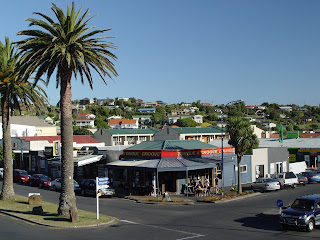As we left the garden at Pukeiti, and descended the slopes of Mt. Taranaki we returned to New Plymouth. Lenny had planned on calling in on a production nursery called Stepping Stones Nursery. Unfortunately by the time we had traveled sufficiently to reach Waitara, the town where the nursery was located, they had closed for the day. Slightly disappointed we checked our map knowing that Titorangi, the garden of Mark and Abbie Jury was in the area. We had planned on calling on them the next day so we could at least find out where it was. As we approached the entrance the sign said, “Open”, there was plenty of afternoon left, so in we went.
Pulling into the gravel drive, we parked quickly and started down the drive, which seems to lead you into the garden. Mark Jury soon met us. Having never met or having a description of him I made my introduction, Lenny did likewise.
I hope that Mark didn’t have plans, or more importantly that Abbie have plans for Mark that afternoon, because he gave us a very generous and in depth tour of the areas and gardens around the house and the valley behind. Mark took over the property and garden from his parents whom had gardened there previously. Garden development on that location had actually started as far back as 1880. Nearly fifty years of garden continuity shows in this wonderful collection of plants.

Tall evergreens form a cathedral like area beneath that contains collection of Bromeliads, as well as shade loving succulents. Massive Rhododendrons define this area from the more open lawn and beds adjoining the house.

A wonderful sunken garden catches you by surprise, once again established planting give a richness that reveal details of the garden bit by bit.
The garden serves as both laboratory and test bed.
Marks father was disappointed with the poor performance of many of the plants from their ancestral home of England, as well as North America. So he began to breed plants and select for better performance and adaptability to the climate of New Zealand.


Mark has inherited the garden, the breeding stock and the talent to take the Jury’s hybrids and selections into the market of today as well as the future. Magnolias, Rhododendrons and Cordylines are just a few of the genera that represent the real thrust of the Jury work. As we approached a shade structure adjacent to the car park we quickly found out this was the nursery area. I had no idea that in addition to maintaining the garden and breeding program, there was a wholesale nursery aspect to Titorangi. There from among a nursery block of Michelia up popped Abbie, Mark’s wife. I think Mark was supposed to be working in the nursery this afternoon, clearly Abby had been working the whole time we were touring, sorry if we put you in hot water Mark. Abie was delightful, a bit of comic relief to Marks’ obvious focus regarding plants. A couple that balances each other nicely. Lenny and I had worked together previously in a large wholesale nursery, so we had a sense of what challenges they had to deal with. The Jury’s indicated that this next year would be their last in the wholesale nursery industry, once the stock was sold out. They would they turn there energies to developing new garden areas that were previously devoted to nursery production as well as current displays that in their opinion were not up to snuff. They seemed genuinely excited about this proposition.

Under the shade cloth structure we sampled the fruit of the Mountain Papaya, for the record pass on that one. We looked at some of the new Cordylines that Mark had bred and was in the process of introducing to the market. Very exciting! However, we back in the states fail to realize the challenges that a plant breeder such as Mark has to wrestle with on this island nation. Plant importation is virtually impossible with current regulations and shows no real change, except for tightening in the future. What does this mean? No new germplasm, new genes, so to speak that can be crossbred to yield vigor or other attributes that make plants desirable, bloom, color, fragrance etc.
Years before, Marks father was able to bring plants to New Zealand with relative ease, not so these days. Since senior did have the opportunity to work with more diverse stock, he had successes of his own. Cordyline ‘Red Fountains’ is a product of Marks fathers’ breeding work, which Mark had realized the potential in and promoted it. This was a new plant to me two years ago, yet it was developed over thirty years ago.

We retired to the terrace for coffee and conversation. Both Abbie and Mark add to this experience, generous with their time and the garden as well. Thank you both.
For the record Abbie, this was not an interview…



















































